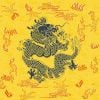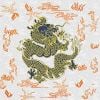Eight Banners
- This article is about the former administrative divisions of China. For other meanings of the term "banner," see banner (disambiguation).
| This article contains Chinese text. Without proper rendering support, you may see question marks, boxes, or other symbols instead of Chinese characters. |
The Eight Banners (In Manchu: ![]() jakūn gūsa, In Chinese: 八旗 baqí) were administrative divisions into which all Manchu families were placed. They provided the basic framework for the Manchu military organization. The fundamental building block of the banners was the company (Manchu:
jakūn gūsa, In Chinese: 八旗 baqí) were administrative divisions into which all Manchu families were placed. They provided the basic framework for the Manchu military organization. The fundamental building block of the banners was the company (Manchu: ![]() niru, Chinese: 佐領 zuoling), some of which reflected pre-existing lineage or tribal connections in their membership, while others deliberately overrode such connections in an effort to create a more centralized military force. Each company was, in principle, required to furnish 300 troops to the larger banner army.
niru, Chinese: 佐領 zuoling), some of which reflected pre-existing lineage or tribal connections in their membership, while others deliberately overrode such connections in an effort to create a more centralized military force. Each company was, in principle, required to furnish 300 troops to the larger banner army.
Establishment
The banners were established by Nurhaci in the early seventeenth century (1615, according to noted historian, Peter C. Perdue) and grew to become the core elite of the Qing empire. Though initially military in nature, the Eight Banners came to assume other administrative duties, including disbursement of salaries, distribution of land, management of property, oversight of popular welfare, and administration of justice. A hierarchy obtained among the Eight Banners, with the so-called three upper banners (Plain Yellow, Bordered Yellow, Bordered White) directly responsible to the emperor himself and five lower banners responsible to imperial princes; later, all the banners were placed under the direct control of the emperor.
Ethnic components
The Eight Banners consisted of three ethnic components: the Manchu, the Han Chinese, and the Mongols. Beginning in the late 1620s, Nurhaci's successors incorporated allied and conquered Mongol tribes into the Eight Banner system. The first Chinese additions were merely sprinkled into existing banners as replacements. Eventually, the sheer numbers of Chinese soldiers caused Manchu leaders to form them into the "Old Han Army" (舊漢軍), mainly for infantry support. In 1631, a separate Chinese artillery corps was formed. Four Chinese banners were created in 1639 and finally the full eight were established in 1642.
Banner soldiers
From the time of the conquest of China (1644 – 1683), the banner soldiers became more professional and bureaucratised. Once the Manchus took over governing, they could no longer satisfy the material needs of soldiers by garnishing and distributing booty; instead, a salary system was instituted, ranks standardised, and the Eight Banners became a sort of hereditary military caste, though with a strong ethnic inflection. Banner soldiers took up permanent positions, either as defenders of the capital, Beijing, where roughly half of them lived with their families, or in the provinces, where some eighteen garrisons were established. The largest banner garrisons throughout most of the Qing dynasty were at Beijing, followed by Xi'an and Hangzhou. Sizable banner populations were also placed in Manchuria and at strategic points along the Great Wall, the Yangtze River and Grand Canal.
Green Standard Army
Over time, many Chinese banner companies in the provincial garrisons were reclassified as civilian or placed in the Green Standard Army. At the end of the Qing dynasty, all members of the Eight Banners, regardless of their original ethnicity, were considered by the Republic of China to be Manchu.
Hierarchical structure
The banners had a hierarchical structure. The smallest unit was niru (or 佐領 zuoling in Chinese; 300 men). The next was jalan (or 參領 canling); 5 niru and 5 jalan consisted a gūsa (banner). Of course, these were ideal numbers and their actual sizes varied substantially.
| niru | jalan | gūsa |
|---|---|---|
Eight Banners
| English | Manchu | Chinese | L/R | U/L | Image |
|---|---|---|---|---|---|
| Plain Yellow Banner | gulu suwayan i gūsa | 正黃旗 zhenghuangqi | Right | Upper | |
| Bordered Yellow Banner | kubuhe suwayan i gūsa | 鑲黃旗 xianghuangqi | Left | Upper | |
| Plain White Banner | gulu šanggiyan i gūsa | 正白旗 zhengbaiqi | Left | Upper | |
| Bordered White Banner | kubuhe šanggiyan i gūsa | 鑲白旗 xiangbaiqi | Left | Lower | |
| Plain Red Banner | gulu fulgiyan i gūsa | 正紅旗 zhenghongqi | Right | Lower | |
| Bordered Red Banner | kubuhe fulgiyan i gūsa | 鑲紅旗 xianghongqi | Right | Lower | |
| Plain Blue Banner | gulu lamun i gūsa | 正藍旗 zhenglanqi | Left | Lower | |
| Bordered Blue Banner | kubuhe lamun i gūsa | 鑲藍旗 xianglanqi | Right | Lower |
Effectiveness
Although the banners were instrumental in the Qing Empire takeover of China proper in the 17th century from the Ming Empire, they began to atrophy in the 18th century, and were shown to be ineffective for modern warfare by the second half of the 19th century. The later banners proved unable to defeat Western powers, such as Britain, in the Opium Wars and were also seriously challenged by the Taiping Rebellion.
Existence
By the late 19th century, the Qing Dynasty began training and creating New Army units based on Western training, equipment and organization. Nevertheless, the banner system remained in existence until the fall of the Qing in 1911, and even beyond, with a rump organization continuing to function until the expulsion of Puyi (the former Xuantong emperor) from the Forbidden City in 1924.
See also
Banners, as an organizational structure, were also used in Mongolia. See Banner (Inner Mongolia).
Credits
New World Encyclopedia writers and editors rewrote and completed the Wikipedia article in accordance with New World Encyclopedia standards. This article abides by terms of the Creative Commons CC-by-sa 3.0 License (CC-by-sa), which may be used and disseminated with proper attribution. Credit is due under the terms of this license that can reference both the New World Encyclopedia contributors and the selfless volunteer contributors of the Wikimedia Foundation. To cite this article click here for a list of acceptable citing formats.The history of earlier contributions by wikipedians is accessible to researchers here:
The history of this article since it was imported to New World Encyclopedia:
Note: Some restrictions may apply to use of individual images which are separately licensed.







